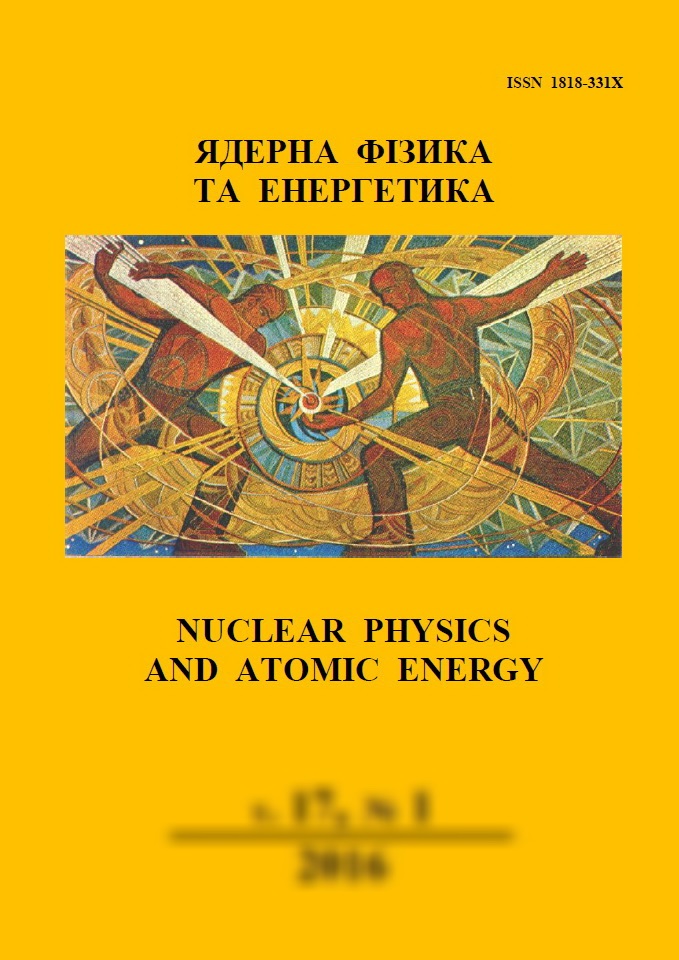 |
Ядерна фізика та енергетика
Nuclear Physics and Atomic Energy
ISSN:
1818-331X (Print), 2074-0565 (Online)
Publisher:
Institute for Nuclear Research of the National Academy of Sciences of Ukraine
Languages:
Ukrainian, English, Russian
Periodicity:
4 times per year
Open access peer reviewed journal
|
Nucl. Phys. At. Energy 2019, volume 20, issue 2, pages 196-204.
Section: Engineering and Methods of Experiment.
Received: 25.06.2018; Accepted: 17.04.2019; Published online: 27.08.2019.
 Full text (ua)
Full text (ua)
https://doi.org/10.15407/jnpae2019.02.196
First research of nickel-lithium-hydrogen heat generator reactions in Kyiv
V. A. Pshenichnyi1, O. O. Gritzay1,*, V. M. Pavlovych1, O. I. Kalchenko1, V. M. Venedyktov1, V. P. Shakhov1, O. V. Dubikovsky2, Т. М. Sabov2, О. V. Kosulja2
1 Institute for Nuclear Research, National Academy of Sciences of Ukraine, Kyiv, Ukraine
2 Institute of Semiconductor Physics, National Academy of Sciences of Ukraine, Kyiv, Ukraine
*Corresponding author. E-mail address:
ogritzay@kinr.kiev.ua
Abstract:
The first observations of the heat release reaction in the nickel-lithium-hydrogen mixture of the A. Rossi heat generator were carried out at the Institute for Nuclear Research of the National Academy of Sciences of Ukraine. The presence of this reaction was recorded using the difference of the e.m.f. thermocouples in two separate reactor chambers with “fuel” and without it, which were inside of the heater. “Fuel” was a nickel powder with 10 % lithium aluminum hydride, total weight of 100 mg. At the first start-up of reactor with “fuel”, the reaction occurs at the temperature of 950 °C and intensively develops up to 1050 °C. Difference e.m.f. thermocouples in two reactor chambers does not exceed 20 °C. For 600 h of observation of this reaction, its behavior was ascertained: under repeated starts, the reaction begins at the temperature of less than 700 °C; the radiation power of gamma quanta with energy above 50 keV, which accompanies this reaction, is less than 0.012 µR/h; the neutron flux in 4π composes 6000 neutrons/h (±40 %); there was change in the isotope composition of 6Li from 7 % for “fuel” to 12 % for “ash”. For nickel isotopes, the decrease in the composition of 60Ni by 2.5 % and the increase in the composition of 62Ni at 0.5 % is indicated. This behavior certainly indicates that a low-energy nuclear reaction (LENR) is observed.
Keywords:
nickel-lithium-hydrogen mixture, low-energy nuclear reaction, gamma quanta, neutrons, isotope composition.
References:
1. A. Rossi, S. Focardi. Experimental test of a mini-Rossi device at the Leonardo corporation, Bologna, 29 March 2011. Journal of Nuclear Physics (2012).
http://www.journal-of-nuclear-physics.com
2. G. Levi et al. Observation of abundant heat production from a reactor device and of isotopic changes in the fuel. Preprint. AMS Acta.
http://amsacta.unibo.it/4084/
3. Nuclear Wallet Cards 2011, 8th Edition.
http://www.nndc.bnl.gov/wallet/wc8.html
4. V.F. Zelensky. Nuclear fusion reactions in vacuum and in matter and two ways of nuclear fusion energy exploration. Preprint NSC KIPT. KIPT-2016-1 (Kharkiv, 2016) 106 p. (Rus)
